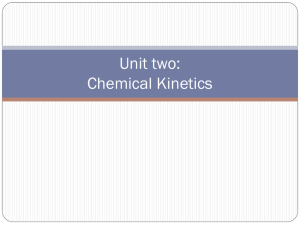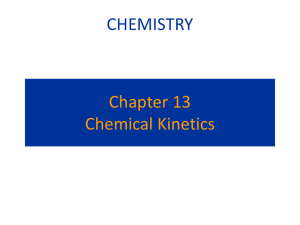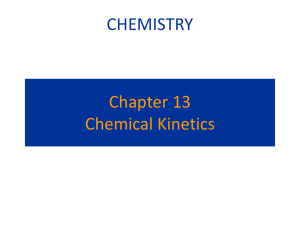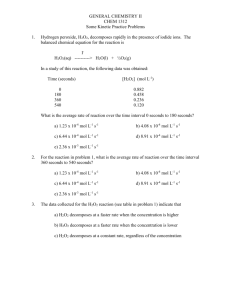aq - Oregon State University
advertisement
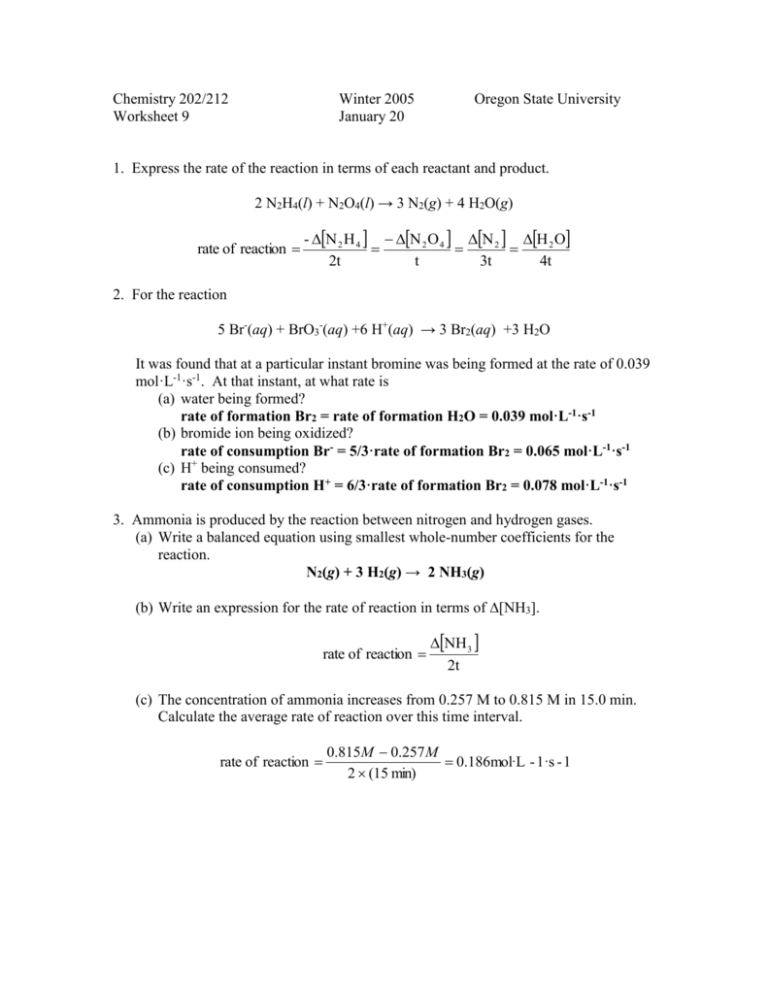
Chemistry 202/212 Worksheet 9 Winter 2005 January 20 Oregon State University 1. Express the rate of the reaction in terms of each reactant and product. 2 N2H4(l) + N2O4(l) → 3 N2(g) + 4 H2O(g) rate of reaction - N 2 H 4 N 2 O 4 N 2 H 2 O 2t t 3t 4t 2. For the reaction 5 Br-(aq) + BrO3-(aq) +6 H+(aq) → 3 Br2(aq) +3 H2O It was found that at a particular instant bromine was being formed at the rate of 0.039 mol·L-1·s-1. At that instant, at what rate is (a) water being formed? rate of formation Br2 = rate of formation H2O = 0.039 mol·L-1·s-1 (b) bromide ion being oxidized? rate of consumption Br- = 5/3·rate of formation Br2 = 0.065 mol·L-1·s-1 (c) H+ being consumed? rate of consumption H+ = 6/3·rate of formation Br2 = 0.078 mol·L-1·s-1 3. Ammonia is produced by the reaction between nitrogen and hydrogen gases. (a) Write a balanced equation using smallest whole-number coefficients for the reaction. N2(g) + 3 H2(g) → 2 NH3(g) (b) Write an expression for the rate of reaction in terms of [NH3]. rate of reaction NH 3 2t (c) The concentration of ammonia increases from 0.257 M to 0.815 M in 15.0 min. Calculate the average rate of reaction over this time interval. rate of reaction 0.815M 0.257 M 0.186mol·L - 1·s - 1 2 (15 min) 4. Experimental data for the following hypothetical reaction are plotted in the figure. (a) Find the instantaneous rate at 40s. 0.004 0.0035 0.003 [X] mol/L Draw a line tangent to the curve at 40s. 0.0008 0.0026mol L1 rate 50 0s 5 rate 3.6 10 mol L1 s 1 Reaction Rate for X -> Y + Z 0.0025 0.002 0.0015 0.001 (b) Find the average rate over the 10 to 50s interval 0.0008 0.0024mol L1 rate 50 10s 5 rate 4 10 mol L1 s 1 0.0005 0 0 10 20 30 40 50 60 tim e (s) (c) Compare the two rates The magnitude of the average rate is greater than the instantaneous rate. (d) Does the rate remain constant over time? No, the magnitude of the rate decreases over time. (e) What does the rate depend upon? The rate is probably dependent upon the concentration of reactants or products. 5. A reaction has two reactants X an Y. What is the order with respect to each reactant and the overall order of the reaction described by the following rate expressions? What are the units for the rate constants (k) if the rate is expressed in mol·L-1·s-1. X Y Overall (a) rate = k1[X]2·[Y] second order first order third order (b) rate = k2[X] first order zero order first order (c) rate = k3[X]2·[Y] 2 second order second order fourth order (d) rate = k4 zero order zero order zero order 6. The equation for the reaction between iodide and bromate ions in acidic solution is 6 I- (aq) + BrO3- (aq) + 6 H+ → 3 I2 (aq) +Br- (aq) +3 H2O The rate of the reaction is followed by measuring the appearance of I2. The following data are obtained: [I-] [BrO3-] [H+] Initial Rate (mol/L·s) 0.0020 0.0080 0.0020 8.89 · 10-5 0.0040 0.0020 0.0020 0.0015 0.0080 0.0160 0.0080 0.0040 1.78 · 10-4 1.78 · 10-4 3.56 · 10-4 7.51 · 10-5 0.0020 0.0020 0.0040 0.0030 (a) What is the order of the reaction with respect to each reactant? [I-] first order [BrO3-] first order [H+] second order (b) Write the rate expression for the reaction. reaction rate = k[I-][BrO3-][H+]2 (c) Calculate k. rate k 1 I BrO 31 H 2 3.56 10 4 mol/L·s 0.0020mol/ L0.0080mol / L 0.0040mol / L 2 k = 1.39·106 L3·mol-3·s-1 (d) What is the hydrogen ion concentration when the rate is 5.00·10-4 mol/L·s and [I-] = 0.5 [BrO3-] = 0.0075 M? H rate 1 k I BrO 31 5.00 10 4 mol / L s 1.39 10 6 L3 mol 3 s 1 0.05mol / L 0.0075mol / L [H+] = 0.00031 M 7. In the first order decomposition of acetone at 500ºC, CH3COCH3 (g) → products It is found that the concentration is 0.0300 M after 200 min and 0.0200 M after 400 min. Calculate the following: (a) the rate constant 0.0300M ln k (400 min 200 min) 0.0200M k = 2.03·10-3 min-1 (b) the half-life A0 ln 1 / 2A0 k t1 / 2 t1/2 = ln2/k =342 min (c) the initial concentration A0 ln k 200 min 0.0300M [A]0 = 0.0300M·e(k·200 min) = 0.0450 M 8. For the zero-order decomposition of ammonia on tungsten NH3(g) → 1/2 N2(g) + 3/2 H2(g) The rate constant is 2.08·10-4 mol·L-1·s-1. (a) What is the half-life of a 0.250 M solution of ammonia? [A] = [A]0 – kt 1/2[A]0 = [A]0 – kt1/2 1/2[A]0 = kt1/2 t1/2 = ½(0.250 mol/L)/( 2.08·10-4 mol·L-1·s-1) = 601 s = 10 min (b) How long will it take for the concentration of ammonia to drop from 1.25 M to 0.388 M? 0.388 M = 1.25 M - ( 2.08·10-4 mol·L-1·s-1)·t t = 4140 s = 1.15 hrs 9. Write the rate expression for each of the following elementary steps. (a) NO + O3 → NO2 + O2 rate = k·[NO]·[O3] (b) 2 NO2 → 2 NO + O2 rate = k·[NO2]2 (c) K + HCl → KCl + H rate = k·[K]·[HCl]





